Enjoy my Whole30-friendly, gluten-free Char Siu, tender Cantonese roasted pork with a sticky-sweet marinade. A healthier twist on the classic, this dish captures the essence of char siu without compromising flavor. Dive into this fab recipe that pays homage to Chinatown BBQ joints.
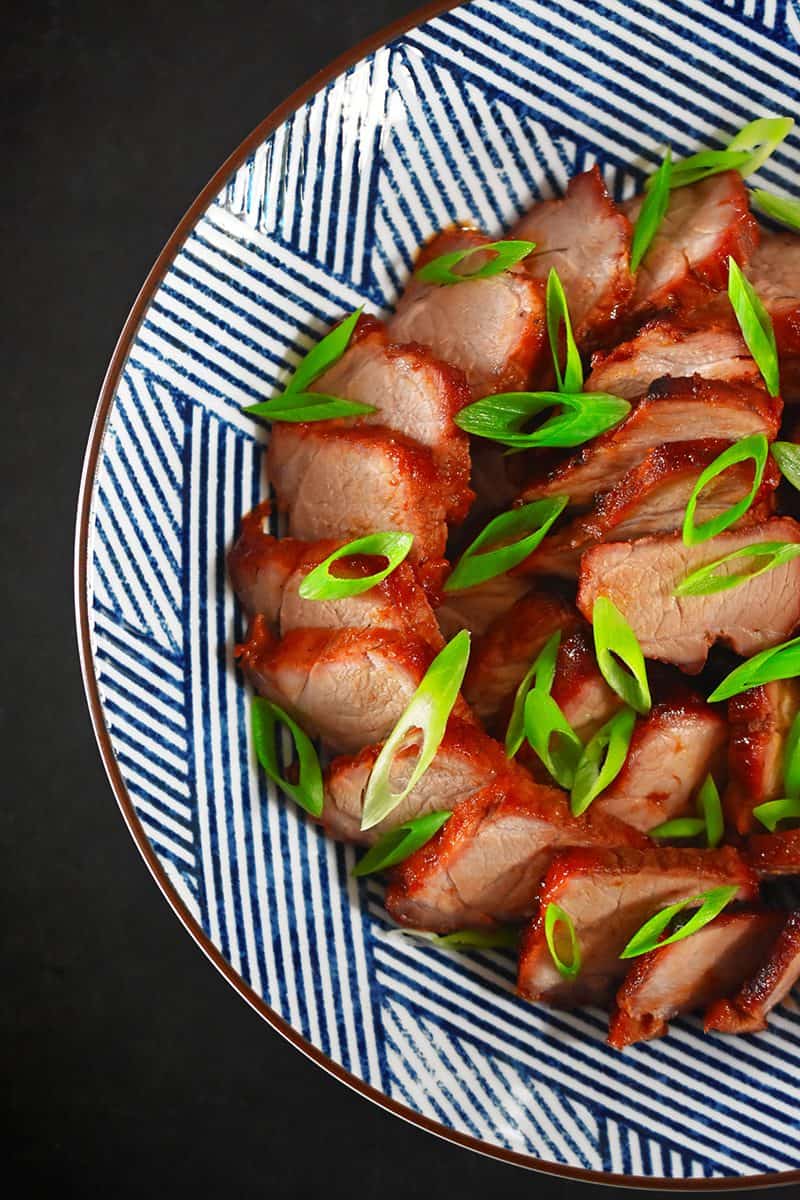
Table of Contents
A paleo remake of a Chinese favorite!
When I first switched to eating Paleo in 2010, the foods I missed eating the most weren’t pizza, pasta, or cake. Even then (waaaay back in the ancient, pre-Instagram era) I knew I could run Internet searches for Paleo-fied substitutes for those dishes. The stuff I craved the most—but couldn’t find adequate replacements for—were the Cantonese dishes of my childhood.
To be clear, these weren’t the barely-recognizable Westernized versions of Chinese recipes; I’m talking about the plates of steaming-hot, perfectly seasoned meats and vegetables that my mom created in our family kitchen in Menlo Park, California, night after night.
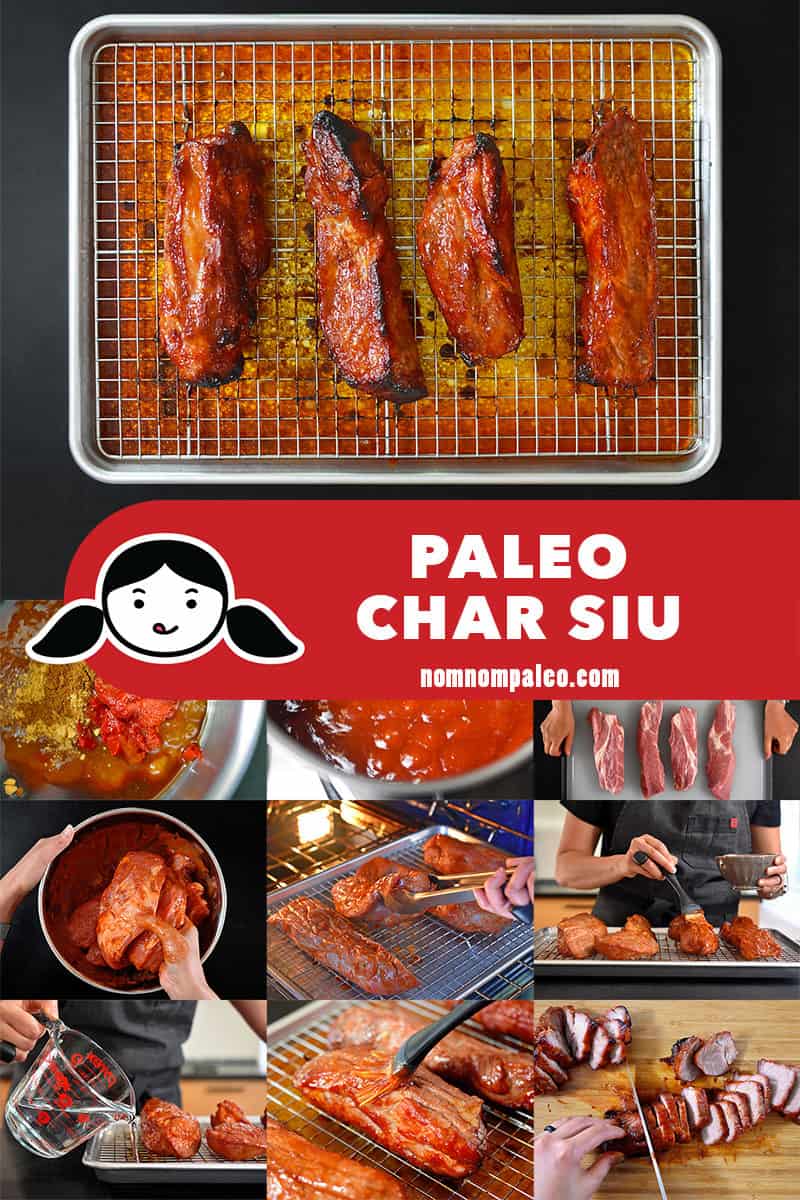
A healthy twist on my mom’s recipe
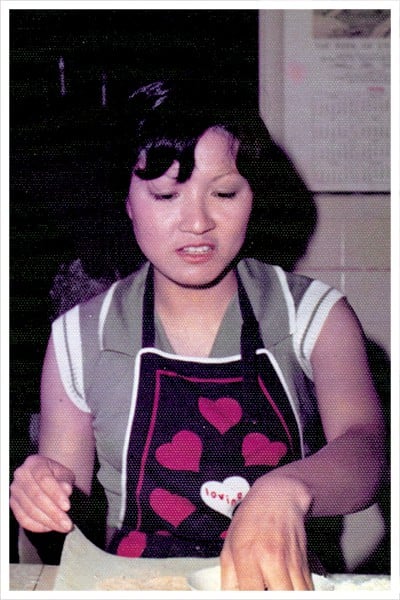
My mother isn’t one to share her secret recipes. (Or, as she says with a shrug, “I don’t know exactly what I put in that dish. Just a little bit of this, and a little bit of that.” Thanks, mom!) But over the years, I’ve cracked the code on a number of my childhood faves, making them Paleo-friendly to boot.
Still, there were some family recipes that I’d long ago decided were impossible to make Paleo, let alone Whole30-friendly.
Many of these dishes demanded non-compliant ingredients (like store-bought hoisin sauce, which contains gluten, sugar, and other non-Paleo ingredients) or required overly complicated steps. I’ll admit that my laziness kept me from attempting a few of these recipes, too.
Persistence pays off!
One of these dishes kept nagging at me: char siu, Chinese barbecue pork lacquered with a sticky-sweet glaze.
You know what I’m talking about: the bright red hunks of meat that hang in the display windows of Chinatown BBQ joints. I missed char siu like crazy—especially my mother’s version.
As a kid, I would linger at my mom’s elbow every time she sliced up her char siu, panting like a puppy desperate to catch a scrap of leftovers. I wasn’t subtle, and refused to budge until my mom slipped me a juicy piece of pork right from the cutting board.
Fueled by these happy food memories and the reminder that persistence pays off, I made it my mission to come up with Paleo version of this porky delight.
But it took longer than I thought it would.
Traditional char siu pork is marinated in a sauce made with soy sauce, hoisin sauce, honey, sugar, wine, five spice powder, and red food coloring or red bean curd—almost all the ingredients are no bueno if you’re paleo and gluten-free.
I’ll spare you the details of my many failed experiments (including the batch that looked amazing, but literally stunk like skunk), but I’m happy to report that after weeks of testing, I finally came up with a char siu recipe that garnered unanimous approval from my finicky kids, my visiting in-laws, and even the pickiest eater in the family: ME.
My Paleo version of char siu is even Whole30-friendly if you use fruit-sweetened jam and leave out the honey!
Ingredients
- Plum, peach or apricot jam: It’s important to use a high-quality, 100% fruit jam in this recipe. I buy St. Dalfour brand (it’s not a sponsor—I just like the stuff, and it’s pretty widely available), and its plum, apricot, and peach spreads work equally well in this recipe.
- Coconut aminos: I like to combine coconut aminos with fish sauce for the perfect soy sauce substitute.
- Tomato paste: Adds umami and a natural red hue to the sauce.
- Almond butter: You can substitute sunflower seed butter or tahini if you can’t use almond butter.
- Red Boat fish sauce
- Chinese five-spice powder
- Ground ginger (a.k.a. ginger powder): No need to use fresh ginger in this recipe!
- Boneless pork shoulder roast or pork butt: I always prefer using this fattier and juicier cut of pork for char siu. I know folks want to use pork tenderloin, but it’s just too lean. Don’t do it!
- Diamond Crystal kosher salt (if using a finer grain salt, only use 1 teaspoon)
- Honey (optional): Leave out if you’re doing a Whole30.
- Green onions (optional garnish)
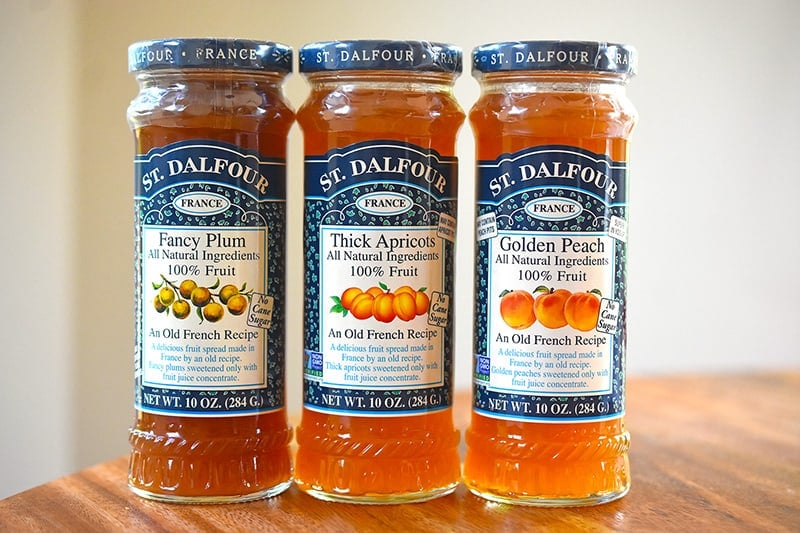
How to make paleo char siu pork
First, make the marinade and cool it to room temperature. Add the jam, coconut aminos, tomato paste, almond butter, honey (omit if you’re doing a Whole30), fish sauce, Chinese five spice powder, and ground ginger to a small saucepan.

Whisk the marinade as you heat it to a simmer over medium heat.
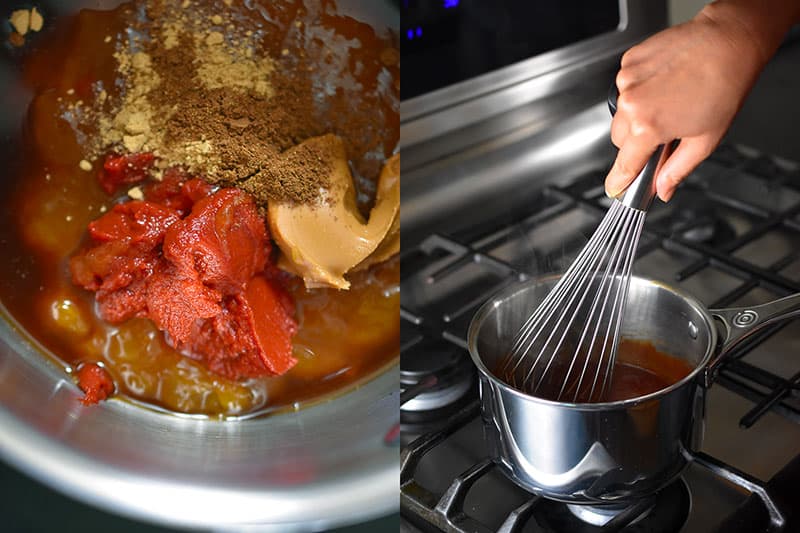
Once the char siu sauce is smooth and bubbling, transfer it to a measuring cup and cool to room temperature. (You can store the marinade in the fridge for up to 4 days and use it when you’re ready to roast the pork.)
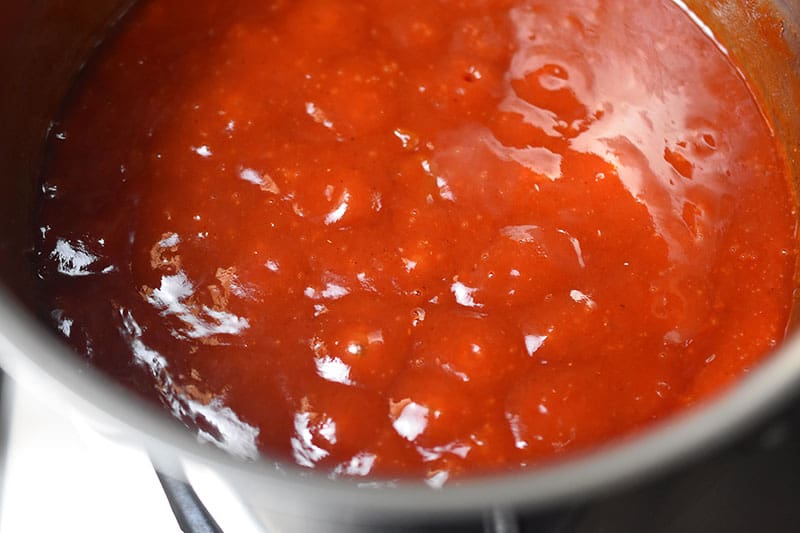
Next, prepare the pork. Blot the pork shoulder dry with a paper towel and slice the meat into 2-inch strips of even thickness.
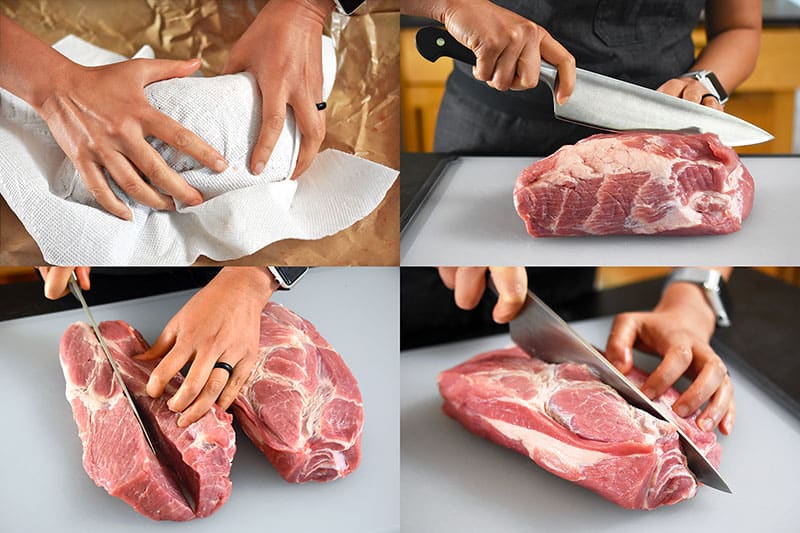
The long strips of pork should be roughly uniform in size. It’s fine to have fatty pieces of pork because: (1) it’s tasty, and (2) you don’t want want to end up with dry char siu.
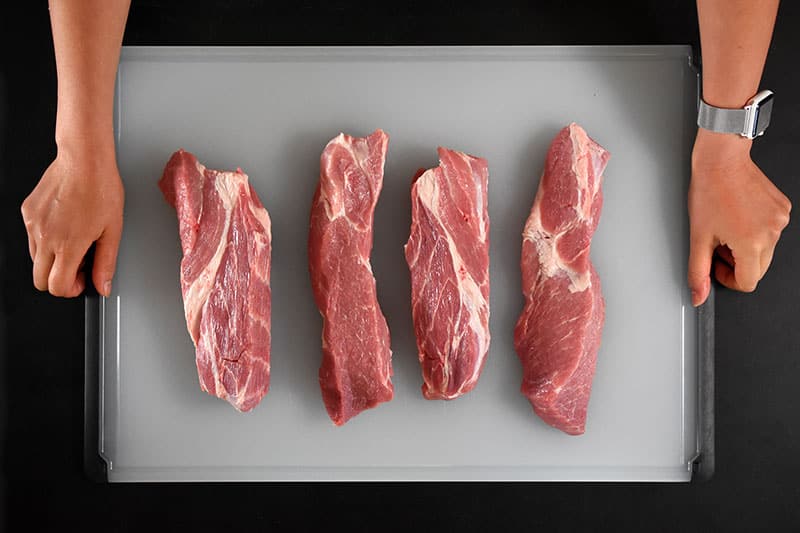
Sprinkle the kosher salt all over the pork pieces. Place the pork in a large bowl or zippered storage bag…
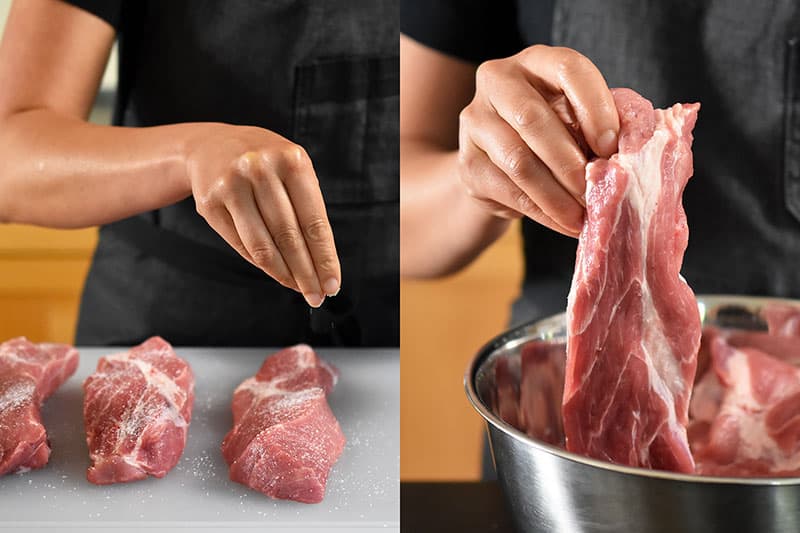
…and pour all except ⅓ cup of the cooled marinade onto the pork. Cover the reserved marinade and store it in the fridge.
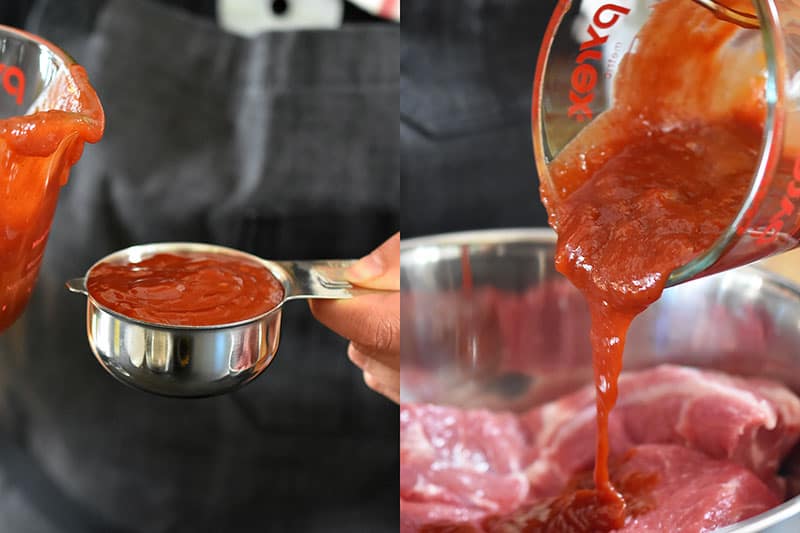
Use your hands (a.k.a. nature’s tongs) to coat the marinade all over the pork strips.
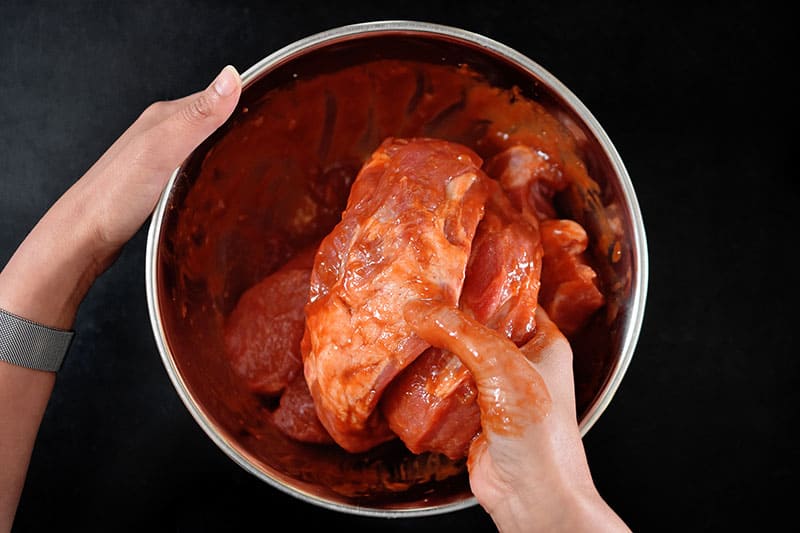
Store the marinated pork in a bowl covered with a silicone lid or plastic wrap and store in the fridge for 2 to 24 hours.
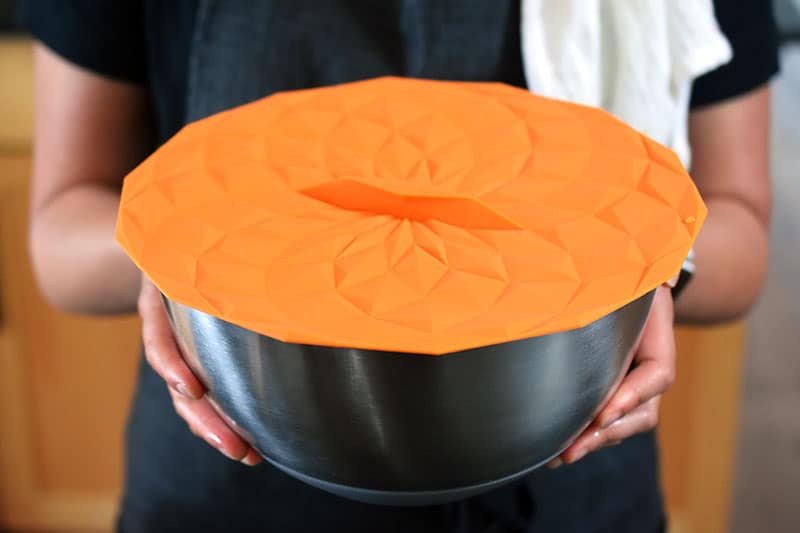
When you’re ready to roast the pork, preheat the oven to 350°F with the rack in the middle position. Place the pork on an oven-safe wire rack in a rimmed baking sheet.
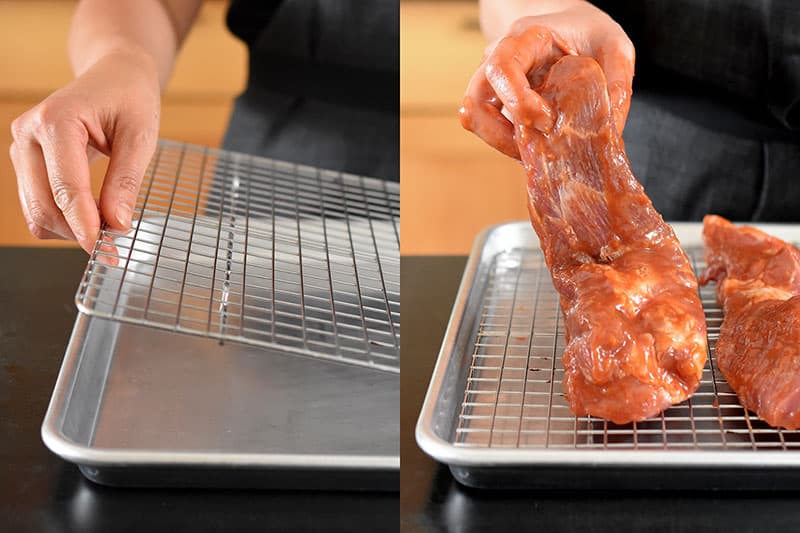
Roast for 30 minutes, flipping the pork pieces at the halfway point.
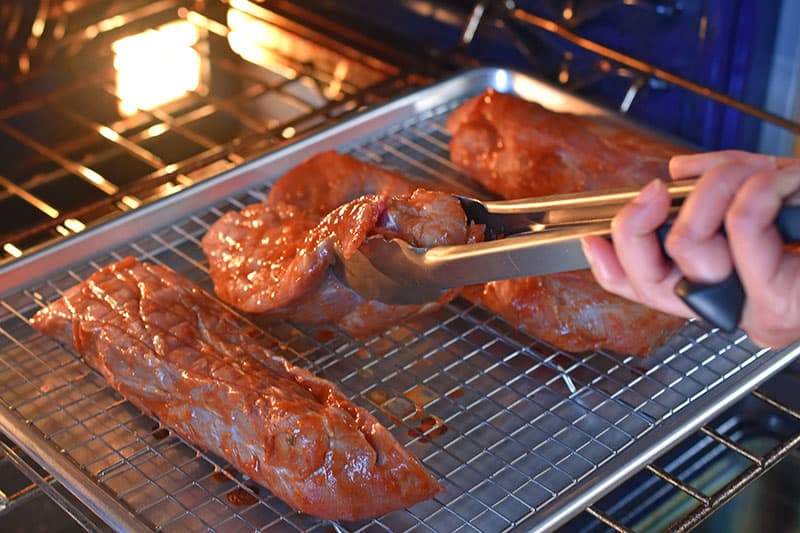
Remove the pork from the oven and increase the oven temperature to 400°F.
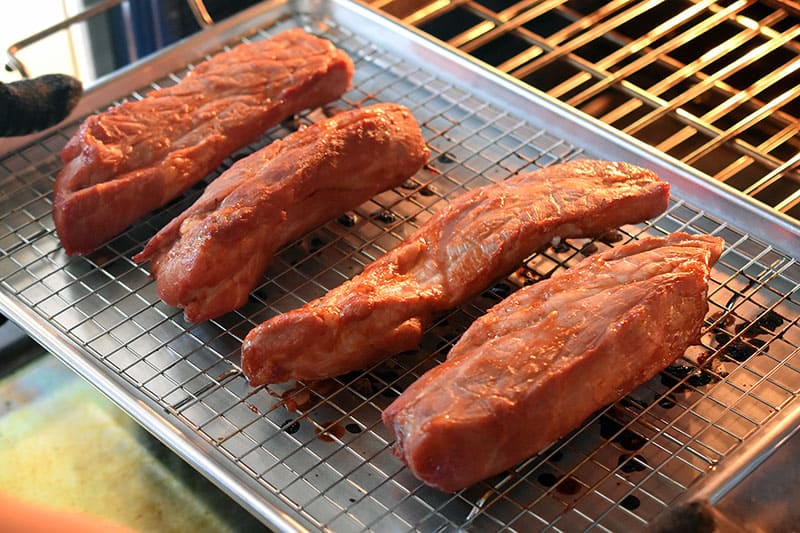
Brush half of the reserved marinade on the top of the pork pieces.
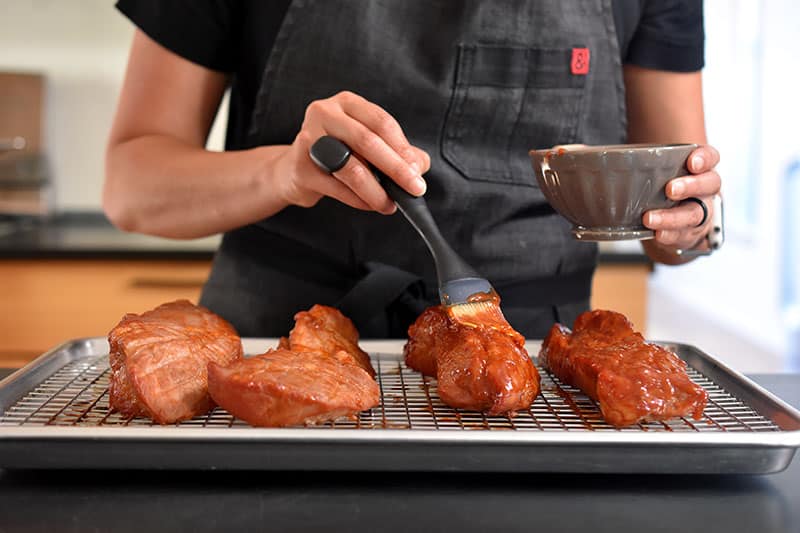
Pour enough water into the bottom of the pan so that you have a thin layer coating the bottom. This will keep the drippings from burning while the pork cooks.
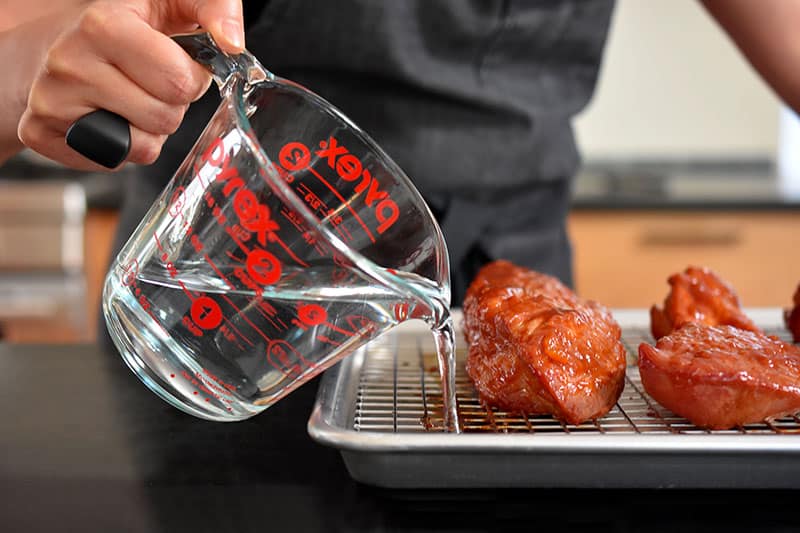
Roast for 25 minutes, and then flip the pork pieces over and brush on the remaining marinade.
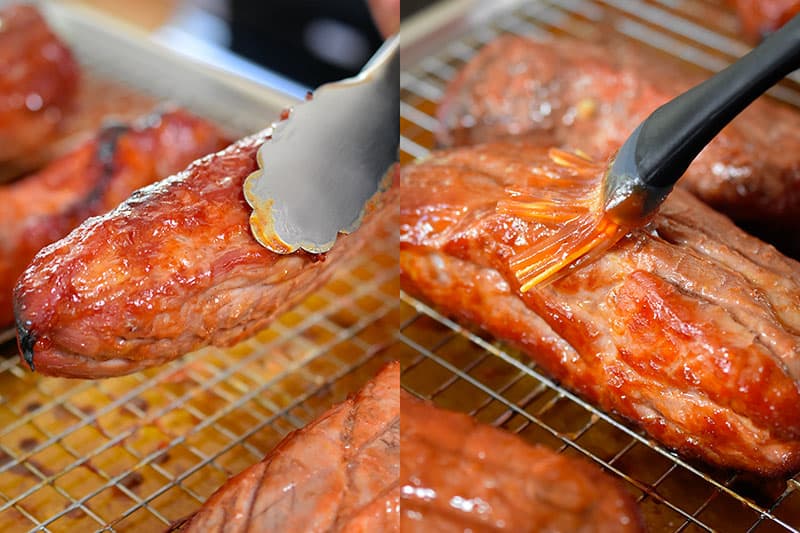
Roast for another 20 to 30 minutes or until the pork is slightly charred on the edges.
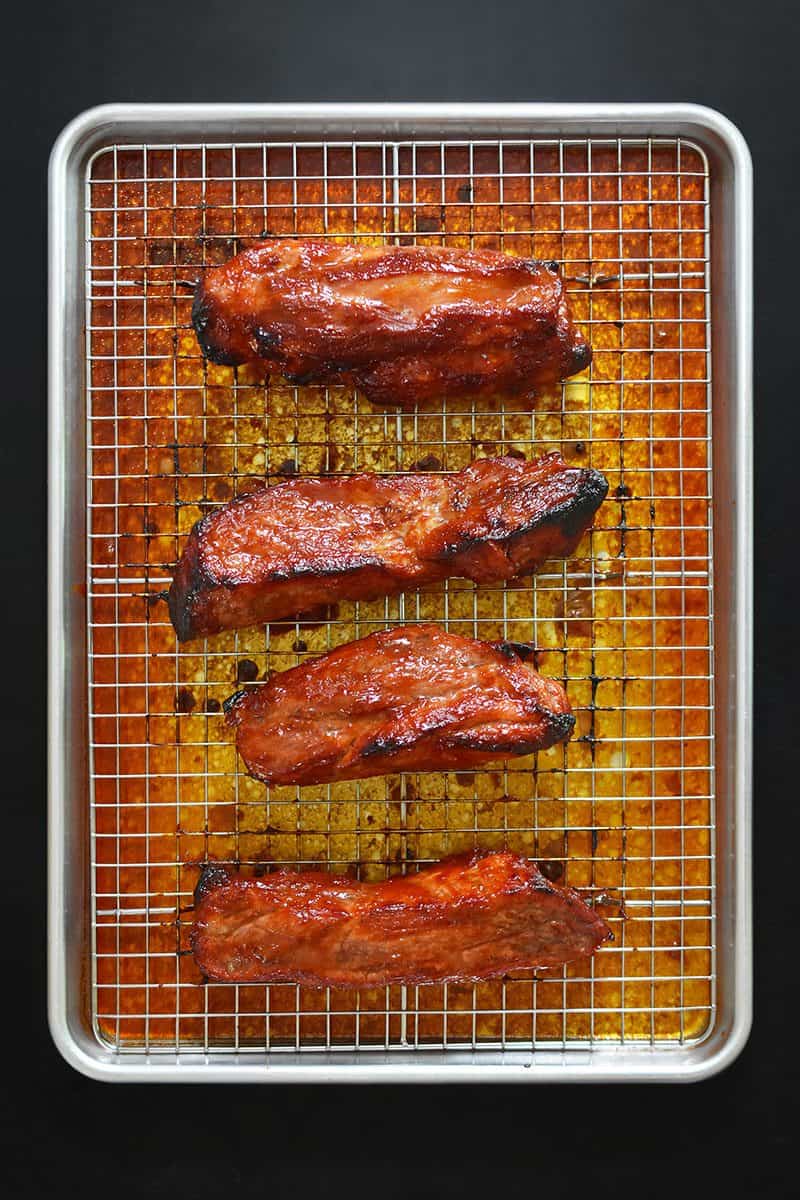
Rest the pork for 10 minutes, and then slice against the grain into chompable pieces!
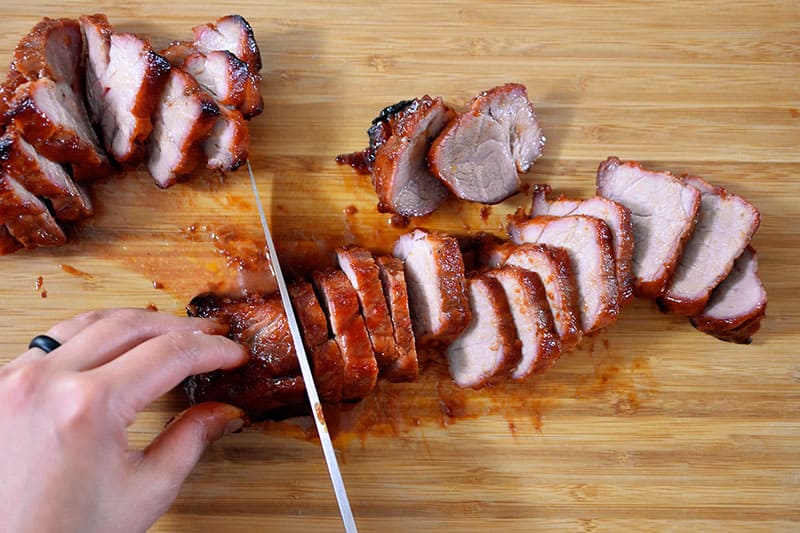
Arrange the pork on a serving dish…
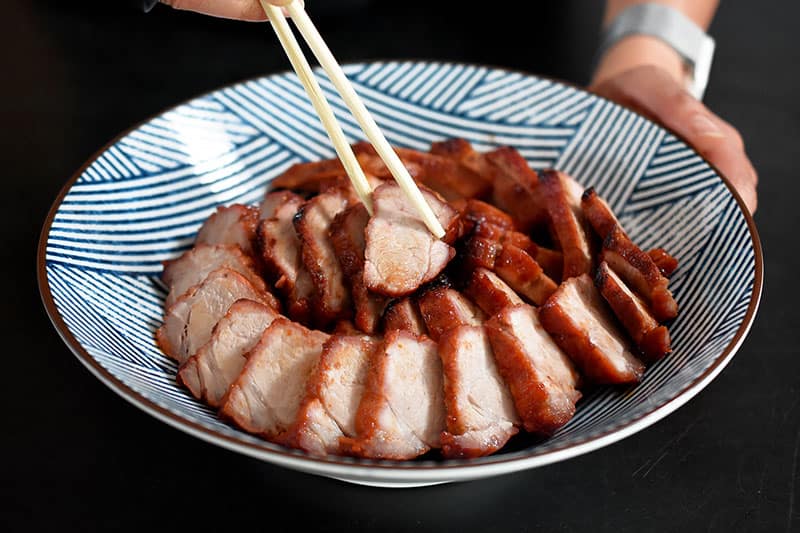
…garnish with sliced scallions, and serve!
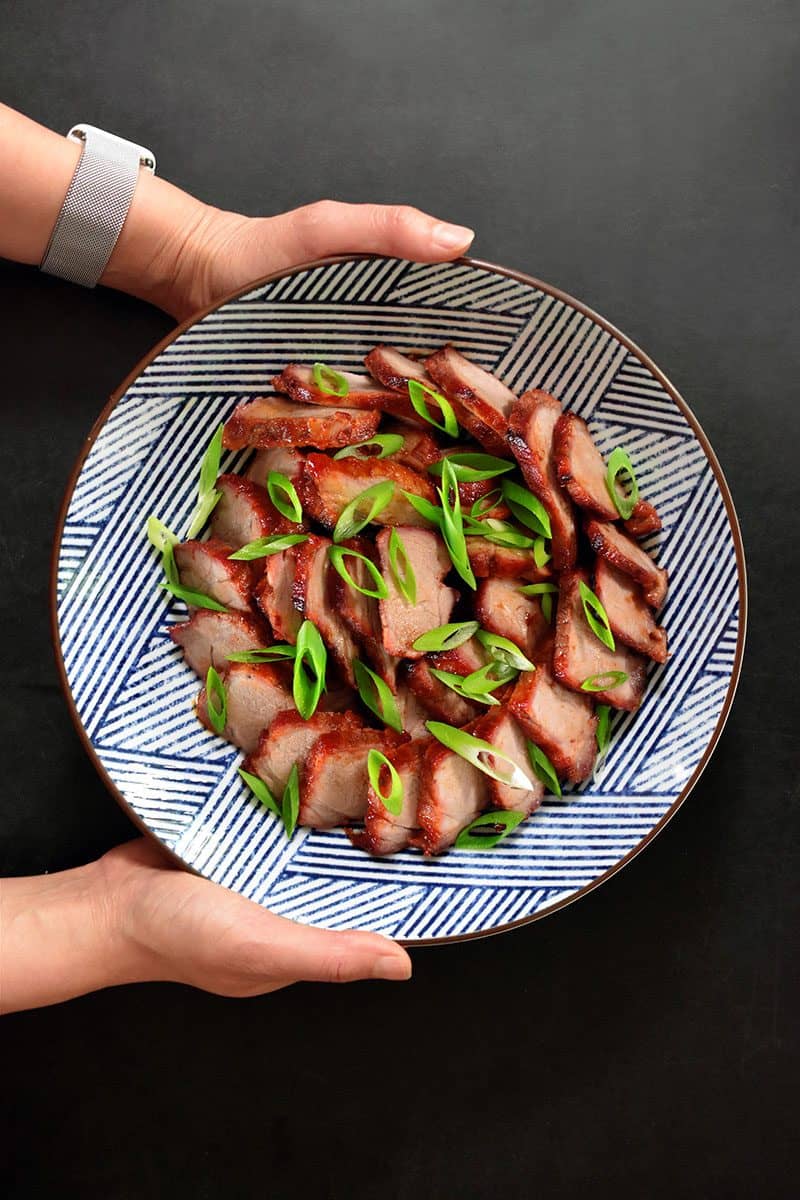
How to save leftovers
Leftovers can be kept in a sealed airtight container in the fridge for up to 4 days or frozen for 3 months. Use the leftovers to make my Asian Cauliflower Fried Rice or Paleo Hiyashi Chuka (Cold Ramen Salad)!
More Paleo Chinese recipes
Looking for more recipe ideas? Head on over to my Recipe Index. You’ll also find exclusive recipes in my cookbooks, Nom Nom Paleo: Food for Humans (Andrews McMeel Publishing 2013), Ready or Not! (Andrews McMeel Publishing 2017), and Nom Nom Paleo: Let’s Go! (Andrews McMeel Publishing 2022).
PRINTER-FRIENDLY RECIPE CARD
Paleo Char Siu (Chinese BBQ Pork)
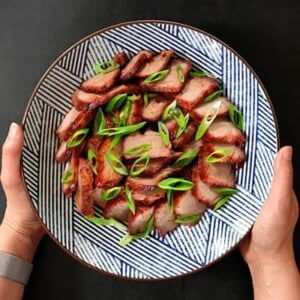
Ingredients
- ½ cup plum jam sweetened with fruit juice (peach and apricot jam also work)
- ¼ cup coconut aminos
- 3 tablespoons tomato paste
- 1 tablespoon almond butter creamy
- 1 tablespoon honey optional
- 1 teaspoon Red Boat fish sauce
- ½ teaspoon Chinese five spice powder
- ½ teaspoon ground ginger
- 3 pounds boneless pork shoulder roast
- 2 teaspoons Diamond Crystal kosher if using a finer grain salt, only use 1 teaspoon
- 2 scallions trimmed and thinly sliced (optional garnish)
Instructions
- Make the marinade and cool it to room temperature: add the jam, coconut aminos, tomato paste, almond butter, honey (if you’re not doing a Whole30), fish sauce, Chinese five spice powder, and ground ginger to a small saucepan. Whisk the marinade as you heat it to a simmer over medium heat.
- Once the sauce is smooth and bubbling, transfer it to a measuring cup and cool to room temperature. (You can store the marinade in the fridge for up to 4 days and use it when you’re ready to roast the pork.)
- Next, prepare the pork. Blot the pork shoulder dry with a paper towel and slice the meat into 2-inch strips of even thickness. The pork strips should be roughly uniform in size. (It’s cool to have fatty pieces of pork because you don’t want want to end up with dry char siu.)
- Sprinkle the kosher salt all over the pork pieces. Place the pork in a large bowl or zippered storage bag and pour all except ⅓ cup of the cooled marinade onto the pork. Cover the reserved marinade and store in the fridge.
- Use your hands to coat the marinade all over the pork strips. Cover the bowl with a silicone lid or plastic wrap and store in the fridge for 2 to 24 hours.
- When you’re ready to roast the pork, preheat the oven to 350°F with the rack in the middle position. Place the pork on an oven-safe wire rack in a rimmed baking sheet.
- Roast the pork for 30 minutes, flipping the pork pieces at the halfway point (15 minutes).
- Remove the pork from the oven and increase the oven temperature to 400°F.
- Brush half of the reserved marinade on the top of the pork pieces. Pour enough water into the bottom of the pan so that you have a thin layer coating the bottom. The water will keep the drippings from burning while the pork cooks.
- Roast the pork for 25 minutes, and then flip the pieces over and brush on the remaining marinade. Roast for an additional 20 to 30 minutes or until the pork is slightly charred on the edges.
- Rest the pork for 10 minutes, and then slice against the grain into chompable slices. Arrange the pork on a serving dish and garnish with sliced scallions, and serve! Leftovers can be kept in the fridge for up to 4 days or frozen for 4 months.
Video
Nutrition
Nutrition information is automatically calculated, so should only be used as an approximation.

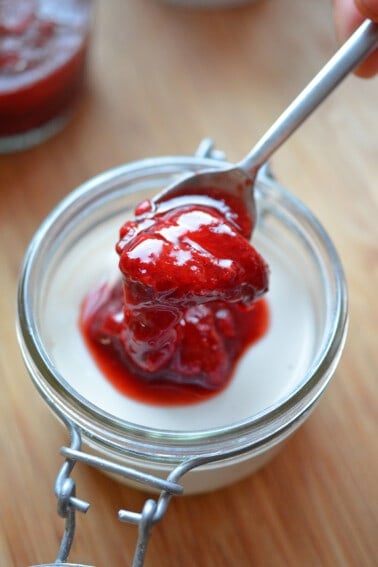
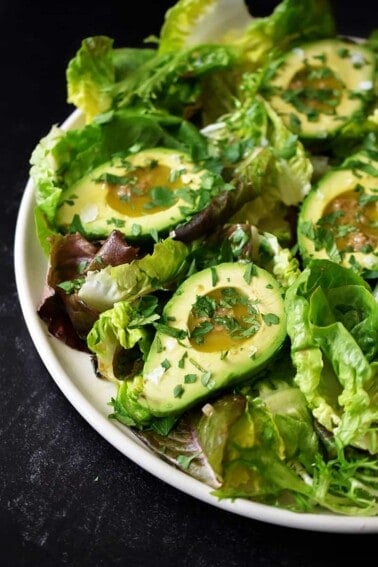
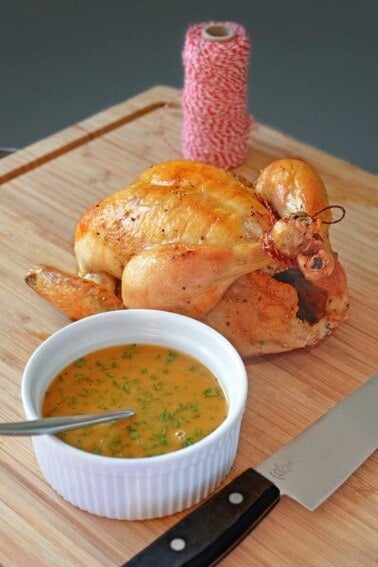
Love this recipe!
This is such an easy to follow recipe. Feels hard because of the steps, but Michelle is always so precise with the descriptions to go along with the pictures.
The pork was absolutely amazing right after resting it. This will be on a regular rotation
This was so yum! My aunts loved it too. One of them said I could add more 5 spices to the recipe. My dad said I should use pork neck. I used pork loin and pork scotch fillets cos they were on sale. Maybe that’s why they were a bit dry. Will pick out pork neck/shoulder, next time. Thanks for the recipe.
So good! Just don’t overcook, like I did. Hard to tell when it is done unless you use an instant read thermometer.
I’ve made this recipe probably 5 or 6 times (delicious, always), but importantly, it was my contribution to Chinese New Year dinner this year. I’m white, my partner is Chinese, and his 97-year-old grandmother, as many Chinese grandmothers do, rarely praises food, even when she likes it. However, she made a point of telling me, in front of everyone, that she liked this char siu “a lot.” I nearly fell over in shock! Thank you, thank you, THANK YOU, Michelle, for this incredible dish and, by extension, bringing this haole a little further into the fold. 😀